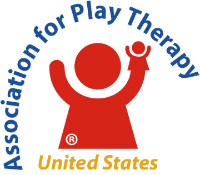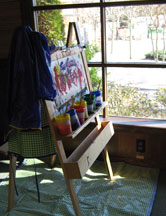By Leslie Petruk, MA, LPC, NCC
 Play therapy is a method of counseling children in a developmentally appropriate way. It allows the therapist to enter the emotional world of the child, rather than requiring a child to enter the cognitive world of adults, which children are unable to do in the way adults often expect them to. Children are unable to perceive and process their experiences in the way adults are. While adults are able to communicate their thoughts and feelings verbally, children use play as their method of communication. Play is a child’s language and in play therapy, the toys are considered to be their “words” and play is a child’s “language”. Through the use of the toys provided in the play room, children exhibit through their play, their internal experiences – how they think and feel.
Play therapy is a method of counseling children in a developmentally appropriate way. It allows the therapist to enter the emotional world of the child, rather than requiring a child to enter the cognitive world of adults, which children are unable to do in the way adults often expect them to. Children are unable to perceive and process their experiences in the way adults are. While adults are able to communicate their thoughts and feelings verbally, children use play as their method of communication. Play is a child’s language and in play therapy, the toys are considered to be their “words” and play is a child’s “language”. Through the use of the toys provided in the play room, children exhibit through their play, their internal experiences – how they think and feel.
Children may become more frustrated because the way they are communicating their thoughts and feelings is often times misunderstood by the adults in their lives. For example, a child who is acting out every morning and refusing to go to school may be communicating that something occurred at school that upset or worries them. Children often do not have the language skills to communicate or express their emotional experiences and at times, may not know how to cope with the feelings they experience. The inability to identify and verbalize their emotional stressors may lead to misbehavior or acting out, depression, anxiety or other problematic ways of coping (i.e. bedwetting, obsessive thoughts, eating problems). When children experience external or internal stress, they may be unable to process or cope with it, which leads to problems and/or distress for both children and their parent(s).
 The way children interpret experiences in their world can lead to difficulties for them. For example, a child whose parents have separated may believe that their father left because of the fight their parents had over who was going to pick them up from school or for some reason it is his/her fault for the split of his/her parents. As a result of this belief, the child may begin to exhibit defiant behavior, act out and/or appear depressed and sad at times.
The way children interpret experiences in their world can lead to difficulties for them. For example, a child whose parents have separated may believe that their father left because of the fight their parents had over who was going to pick them up from school or for some reason it is his/her fault for the split of his/her parents. As a result of this belief, the child may begin to exhibit defiant behavior, act out and/or appear depressed and sad at times.
Play therapy allows a child to use the toys (their words) and play (their language) as a way to communicate their beliefs, fears, feelings and thoughts. A trained play therapist is able to interpret the play themes of a child to understand their internal experiences and help them work through the problematic thoughts and feelings they are having.
Scheduling a consistent appointment time each week is helpful in providing consistency and predictability for the child who enters play therapy. This also provides continuity and more efficient treatment. Eventually, the play therapist will begin to spread sessions out when a child begins to exhibit signs that they are ready for less frequent sessions.
The play therapy room is a “special play room” in which a child develops a sense of safety, in the presence of the play therapist, to express their thoughts and feelings. Through the use of the toys (their words) they communicate through their play (their language). The toys provide safe objects for them to play out their internal experiences in a symbolic manner. The toys provide enough distance and safety from their own feelings and reactions that they can express them through the use of the toys and their play. Their play themes, over time, communicate their inner conflicts and/or stressors.
When children are provided a safe and protected environment they will communicate their inner experiences, worries, conflicts and needs.
“By acting out through play a frightening or traumatic experience or situation symbolically, and perhaps changing or reversing the outcome in the play activity, children move toward an inner resolution, and then they are better able to cope with or adjust to problems.”
(Landreth & Bratton, 2001)
Through their play, children are able to play out a desired outcome and work through the emotional distress surrounding an event(s) that are stressful to them. This facilitates an emotional understanding and processing in a way that makes sense to the child and provides for some emotional resolution and/or healing.
 When provided the opportunity within a safe environment and the proper “tools” along with a therapist who is accepting of the child and their feelings, children will entrust the therapist with their inner experiences, conflicts, needs, and hurts. Children are unable to articulate verbally their experiences and how they have affected them. In the therapeutic environment children will reveal these internal experiences through their play, the choice of toys and activities they choose and how they interact with the toys and the therapist. It is in their interactions (or lack thereof) with the therapist and the toys and the themes that emerge in their play over time that communicates their inner experiences, fears and challenges. The child is given the freedom to choose what toys, art activities or materials they use and how they use them.
When provided the opportunity within a safe environment and the proper “tools” along with a therapist who is accepting of the child and their feelings, children will entrust the therapist with their inner experiences, conflicts, needs, and hurts. Children are unable to articulate verbally their experiences and how they have affected them. In the therapeutic environment children will reveal these internal experiences through their play, the choice of toys and activities they choose and how they interact with the toys and the therapist. It is in their interactions (or lack thereof) with the therapist and the toys and the themes that emerge in their play over time that communicates their inner experiences, fears and challenges. The child is given the freedom to choose what toys, art activities or materials they use and how they use them.
The play therapy process can be viewed as a relationship between the therapist and the child in which the child utilizes play to explore his or her personal world and also to make contact with the therapist in a way that is safe for the child. Play therapy provides an opportunity for children to live out, during play, experiences and associated feelings. This process allows the therapist to experience, in a personal and interactive way, the inner dimensions of the child’s world. This therapeutic relationship is what provides dynamic growth and healing for the child. (Landreth & Bratton, 2001).
When a child enters the play room they are not met with a list of rules and “do’s and don’ts. A child is told the following: “This is my special play room and in here you can do almost anything. You can choose the toys you would like to play with and how you would like to spend your time. Everything you do and say in here will stay in this room between you and me, unless you tell me that someone is hurting you or a judge orders me to tell them about our time together.” If a child breaks a rule, i.e. throwing sand, trying to break a toy, then a limit is set: “I know it’s fun to throw sand, but the sand is not for throwing. You can play with it in the sand trays and toss it from hand to hand, or you can throw a ball.” Children require limits and boundaries in any relationship to feel safe and accepted. The relationship between a child and play therapist is no different. The therapeutic relationship established in play therapy is one of trust, acceptance, and in which the child is valued, but it is not without boundaries. During a child’s play time, they are allowed to be messy, are encouraged to explore, doing something in a specific or directed way is not required. The therapist in no way controls what the child does or how they do it. Limits are set if they are doing harm to themselves, the toys or the therapist. Limits are set if and when they are needed in order to help the child learn responsibility of self and self-control. Limits are set in a way which validates the child’s feelings/desire, communicates the limit and gives alternatives i.e. “It would be fun to cut the dolls hair. The scissors are for cutting paper. You can cut the paper with the scissors or use your finger to cut the dolls hair.” This then allows the child to learn the concept of self-control and making choices, rather then an adult attempting to control their behavior.
 Play therapy has been widely researched as an effective and developmentally appropriate method for working with children dealing with (but not limited to) the following: depression, grief and loss, social adjustment problems, speech difficulties, trauma, hospitalization, reading difficulties, selective mutism, enuresis and encopresis problems, fear and anxiety, abuse & neglect, aggression/acting out behaviors, attachment difficulties/issues, autism, burn victims, chronic illness, parental separation/divorce, deaf and physically challenged children, withdrawn children.
Play therapy has been widely researched as an effective and developmentally appropriate method for working with children dealing with (but not limited to) the following: depression, grief and loss, social adjustment problems, speech difficulties, trauma, hospitalization, reading difficulties, selective mutism, enuresis and encopresis problems, fear and anxiety, abuse & neglect, aggression/acting out behaviors, attachment difficulties/issues, autism, burn victims, chronic illness, parental separation/divorce, deaf and physically challenged children, withdrawn children.
